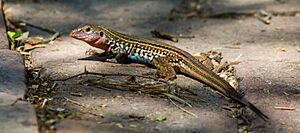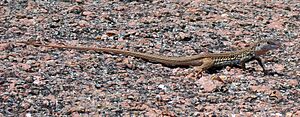Texas spotted whiptail facts for kids
Quick facts for kids Texas spotted whiptail |
|
|---|---|
 |
|
| Texas spotted whiptail (Aspidoscelis gularis), male, Hidalgo County, Texas | |
| Conservation status | |
| Scientific classification | |
| Genus: |
Aspidoscelis
|
| Species: |
gularis
|
| Synonyms | |
|
|
The Texas spotted whiptail (Aspidoscelis gularis) is a type of lizard with a very long tail. It belongs to the family called Teiidae. This lizard lives only in certain parts of the southern United States and northern Mexico. There are six different kinds, or subspecies, of the Texas spotted whiptail.
Contents
Where Do Texas Spotted Whiptails Live?
You can find the Texas spotted whiptail in several states in the U.S. These include New Mexico, Oklahoma, and Texas. They also live in many states in Mexico. Some of these Mexican states are Coahuila, Nuevo León, and Tamaulipas.
What Does a Texas Spotted Whiptail Look Like?
The Texas spotted whiptail can grow to be about 6.5 to 11 inches (16 to 28 cm) long. This measurement includes its long tail. They are usually tan, brown, or green-brown in color.
They have seven clear stripes that run along their body. These stripes are often grey or white. You might also see light spots on their sides. Their belly is always white.
Male whiptails often have a red throat and a blue belly. They might also have black or blue spots on their chest. Female whiptails usually have a pink throat. Their tail is very long, often three times longer than their body. The tail is usually a plain peach or tan color.
Behavior and Habitat
The Texas spotted whiptail is a daytime animal. This means it is active during the day. It mainly eats insects. These lizards are very active and move around a lot.
They can live in many different places. You might find them in grassland areas or dry regions. They also live in canyons and rocky places. They usually stay close to a source of water.
Reproduction and Life Cycle
Texas spotted whiptails that are old enough to have babies breed in the spring. The female lizard will lay a group of eggs in the early summer. She usually lays between 1 and 5 eggs at a time.
Subspecies of the Texas Spotted Whiptail
There are six recognized subspecies of the Texas spotted whiptail. A subspecies is like a slightly different version of the same animal. They might have small differences in where they live or how they look.
- Aspidoscelis gularis gularis
- Aspidoscelis gularis colossus
- Aspidoscelis gularis pallidus
- Aspidoscelis gularis rauni
- Aspidoscelis gularis semiannulatus
- Aspidoscelis gularis semifasciatus
The name rauni for one of the subspecies honors an American zoologist named Gerald George Raun.




